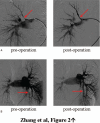Percutaneous treatment for silicosis-induced pulmonary artery stenosis: A case report and review of the literature
- PMID: 29480834
- PMCID: PMC5943882
- DOI: 10.1097/MD.0000000000009469
Percutaneous treatment for silicosis-induced pulmonary artery stenosis: A case report and review of the literature
Abstract
Background: Exposure to crystalline silica results in silicosis with initiation and progression of pulmonary fibrosis. The impaired lung parenchyma leads to pulmonary arterial hypertension and increased pressure in the right ventricle of the heart. Usually, the silicosis may be followed by enlargement of hilar lymphnodes, but silicosis-induced pulmonary artery stenosis with severe pulmonary hypertension is rare. Percutaneous pulmonary artery stenting and balloon angioplasty were performed to relieve stenosis and pulmonary hypertension.
Methods: We report the case of a 52-year-old man who was admitted for persistent dyspnea for 2 years and progressive dyspnea for half a month. He had been a stonemason for 20 years. The computer tomography pulmonary angiography scan images showed partially fibrotic lungs with a disseminated nodular pattern and enlarged bilateral hilar and mediastinal lymphnodes. The echocardiogram and right heart catheterization confirmed the diagnosis of severe pulmonary arterial hypertension.
Results: Pulmonary angiograms showed severe stenosis of the proximal upper right and lower left pulmonary artery. Moderate stenosis occured in a branch of the lower right pulmonary artery and a branch of the upper left pulmonary artery. A total of 2 stents and 4 balloons were used to relieve lesions. The final angiograms showed a significantly increased pulmonary artery caliber. The clinical symptom and 6-minute walk distance of the patient were much improved.
Conclusion: To our knowledge, this is the first reported case of percutaneous treatment for silicosis-induced pulmonary artery stenosis and pulmonary hypertension. The clinical symptom, 6-minute walking test, and vessel caliber at areas of stenosis improved significantly following stent implantation and balloon dilatation. However, the patient was followed up for a short period and long-term outcomes have not yet been sufficiently evaluated.
Copyright © 2017 The Authors. Published by Wolters Kluwer Health, Inc. All rights reserved.
Conflict of interest statement
The authors report no conflicts of interest.
Figures


Similar articles
-
Stent treatment of ostial branch pulmonary artery stenosis: initial and medium-term outcomes and technical considerations to avoid and minimise stent malposition.Cardiol Young. 2020 Feb;30(2):256-262. doi: 10.1017/S1047951119003032. Epub 2019 Dec 13. Cardiol Young. 2020. PMID: 31831087
-
[Stent implantation for relief of pulmonary artery branch stenosis].Zhonghua Er Ke Za Zhi. 2014 May;52(5):358-61. Zhonghua Er Ke Za Zhi. 2014. PMID: 24969934 Chinese.
-
Long-Term Outcomes After Percutaneous Transluminal Pulmonary Angioplasty in Patients With Takayasu Arteritis and Pulmonary Hypertension.Front Immunol. 2022 Mar 11;13:828863. doi: 10.3389/fimmu.2022.828863. eCollection 2022. Front Immunol. 2022. PMID: 35359930 Free PMC article.
-
Pulmonary Artery Stenting.Interv Cardiol Clin. 2019 Jan;8(1):33-46. doi: 10.1016/j.iccl.2018.08.005. Epub 2018 Oct 25. Interv Cardiol Clin. 2019. PMID: 30449420 Review.
-
Treatment approach to unilateral branch pulmonary artery stenosis.Trends Cardiovasc Med. 2021 Apr;31(3):179-184. doi: 10.1016/j.tcm.2020.02.001. Epub 2020 Feb 10. Trends Cardiovasc Med. 2021. PMID: 32081565 Review.
Cited by
-
Pulmonary hypertension due to silicosis and right upper pulmonary artery occlusion with bronchial anthracofibrosis.Respir Med Case Rep. 2021 Oct 2;34:101522. doi: 10.1016/j.rmcr.2021.101522. eCollection 2021. Respir Med Case Rep. 2021. PMID: 34646731 Free PMC article.
-
Successful simultaneous stenting of a pulmonary artery and vein in pulmonary vascular stenosis due to silicosis. Case report and literature review.Front Cardiovasc Med. 2023 May 9;10:1108768. doi: 10.3389/fcvm.2023.1108768. eCollection 2023. Front Cardiovasc Med. 2023. PMID: 37229232 Free PMC article.
-
Unveiling the threat of crystalline silica on the cardiovascular system. A comprehensive review of the current knowledge.Front Cardiovasc Med. 2025 Feb 14;12:1506846. doi: 10.3389/fcvm.2025.1506846. eCollection 2025. Front Cardiovasc Med. 2025. PMID: 40027509 Free PMC article. Review.
-
Type 1 Pulmonary Hypertension and Silicosis in a Bluestone Cutter: A Case Report on Raising Awareness.Cureus. 2023 Feb 24;15(2):e35425. doi: 10.7759/cureus.35425. eCollection 2023 Feb. Cureus. 2023. PMID: 36999113 Free PMC article.
-
Global scenario of silica-associated diseases: A review on emerging pathophysiology of silicosis and potential therapeutic regimes.Toxicol Rep. 2025 Jan 31;14:101941. doi: 10.1016/j.toxrep.2025.101941. eCollection 2025 Jun. Toxicol Rep. 2025. PMID: 39989982 Free PMC article. Review.
References
-
- Hughes JM, Weill H, Checkoway H, et al. Radiographic evidence of silicosis risk in the diatomaceous earth industry. Am J Respir Crit Care Med 1998;158:807–14. - PubMed
-
- Bessis L, Callard P, Gotheil C, et al. High-resolution CT of parenchymal lung disease: precise correlation with histologic findings. Radiographics 1992;12:45–58. - PubMed
-
- Nemmar A, Vanbilloen H, Hoylaerts MF, et al. Passage of intratracheally instilled ultrafine particles from the lung into the systemic circulation in hamster. Am J Respir Crit Care Med 2001;164:1665–8. - PubMed
-
- Seaton A, MacNee W, Donaldson K, et al. Particulate air pollution and acute health effects. Lancet 1995;345:176–8. - PubMed
Publication types
MeSH terms
LinkOut - more resources
Full Text Sources
Other Literature Sources

